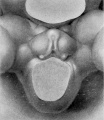Search results
From Embryology
- ...e>[[Category:Template]][[Category:Carnegie Collection]][[Category:Carnegie Embryo]]</noinclude>149 bytes (15 words) - 12:07, 8 June 2017

File:Spaulding-plate01.jpg [[Category:Carnegie Embryo 1784a]] [[Category:Carnegie Embryo 1936]](1,266 × 2,000 (392 KB)) - 07:38, 8 November 2017
File:Spaulding-fig03.jpg ==Fig. 3. Carnegie Embryo No. 2702== ...rmer (fig. 3) the urethral and anal membranes have not ruptured. The older embryo (fig. 4) agrees with the finding that (in the majority of cases) these memb(646 × 748 (83 KB)) - 10:50, 8 May 2015- ...are not Carnegie stages, use the embryo CRL to approximately convert to [[Carnegie Stages]]. ...bryology_15|Historic - Urogenital Development]] | [[Carnegie Embryos]] | [[Carnegie Collection]]72 KB (11,235 words) - 23:39, 3 June 2019
- ...dia Differentiate by Following a Precise Timeline in Human Embryos Between Carnegie Stages 11 and 13=== ...d primordia in human somite-stage embryos. We selected 37 human embryos at Carnegie Stage (CS) 11-CS13 (28-33 days after fertilization) and three-dimensionally44 KB (6,445 words) - 23:23, 24 August 2020
- perioticular cistern in the human embryo. Nine figures 299 Embryo868 KB (135,918 words) - 12:43, 4 August 2019
- ...f the Scala tympani, Scala vestibuli and perioticular cistern in the human embryo. Nine figures 299 Embryo 12.84852 KB (135,906 words) - 23:12, 17 December 2019